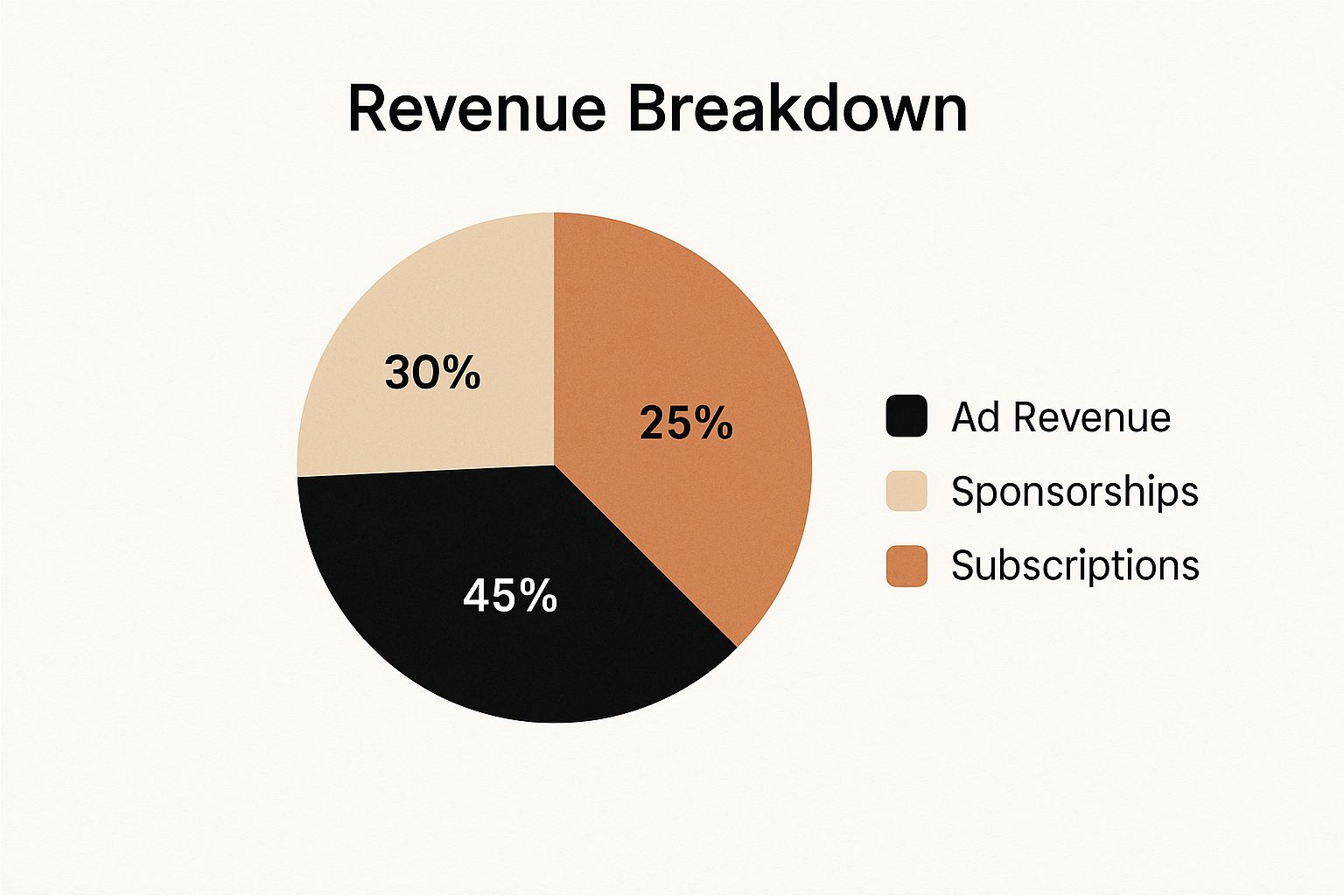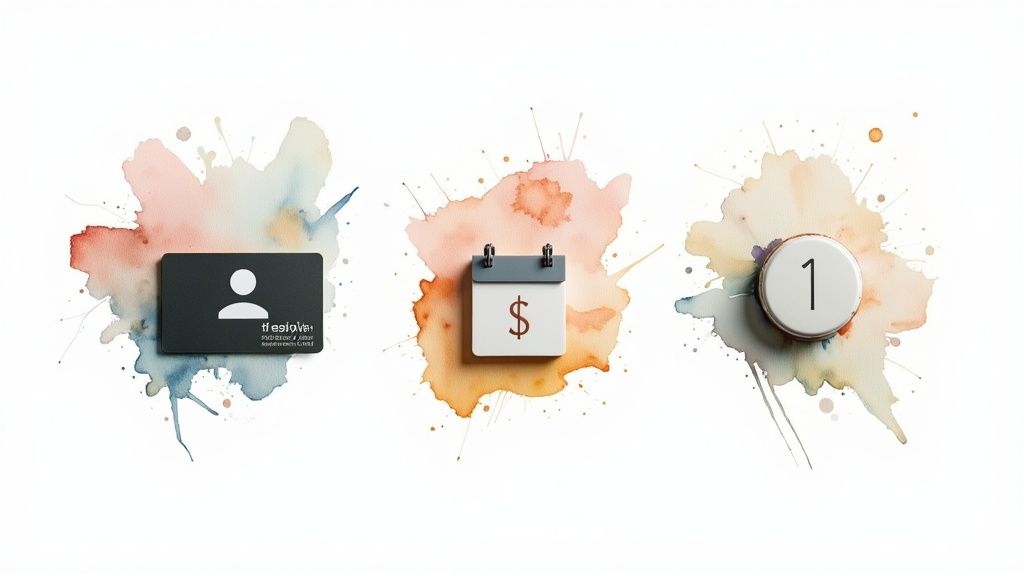Discover how to monetize content with proven strategies. Learn to build a monetization foundation, use AI-driven video, and scale your revenue effectively.
In This Article
Subscribe to our newsletter
Turning your articles, videos, and other digital assets into actual revenue is what we mean by "content monetization." It’s about building a diverse income stream around your work—think advertising, subscriptions, and affiliate marketing—so you're not relying on a single source of cash. This is how you build a truly sustainable media business.
The Publisher's New Playbook for Monetization
If you're still just slapping banner ads on your site and hoping for the best, I have some bad news. That playbook is officially collecting dust on a shelf somewhere.
The most successful modern publishers have figured out that real monetization comes from building a diverse revenue ecosystem. And at the center of that ecosystem? Deep audience engagement. This isn't just about selling ad space anymore; it's about creating genuine value that your audience is willing to support, either with their attention or their wallets.
This shift isn't happening in a vacuum. It's a direct response to how people consume content today. Audiences are savvy, and their attention is split across a million different apps and platforms. They expect more than just a wall of text. For media teams ready to adapt, this is where the real opportunity is.
The Shift to a Value-Driven Model
The new playbook is all about creating tangible value. Instead of just pushing content at people, the goal is to pull them in.
Let's take a publisher focused on financial news as an example. In the old days, they would have leaned heavily on programmatic ad revenue generated from high traffic volume. That was it.
Today, a much smarter and more resilient strategy would look something like this:
- Core Content: High-quality articles, available for free, to attract the widest possible audience.
- Premium Layer: In-depth market analysis and exclusive interviews, tucked behind a paywall for paying subscribers.
- Affiliate Links: Smart recommendations for financial software or brokerage accounts that earn a commission when a reader signs up.
- Video Summaries: Quick, digestible video breakdowns of complex financial news, monetized with pre-roll ads.
This multi-pronged approach gives you several ways to generate revenue while catering to different audience segments, from the casual browser to the die-hard fan.
The core principle here is simple: The deeper the engagement, the higher the monetization potential. A casual reader might bring in a few cents from ad impressions. But a loyal subscriber who trusts your brand? They could be worth hundreds of dollars a year.
The Growing Market and the Role of AI
This push for smarter monetization is happening inside a market that's absolutely exploding. The global digital content creation market was valued at USD 27.1 billion in 2023 and is on track to hit USD 49.5 billion by 2028.
This incredible growth puts a ton of pressure on publishers, but it also creates a massive opportunity to grab a piece of that pie. You can explore more digital content creation statistics to get a better sense of where the market is headed.
Staying competitive means you have to be efficient and innovative. This is where AI-driven tools, like Aeon’s video creation platform, become a game-changer.
Imagine turning one of your top-performing articles into a professional-quality video in a matter of minutes, not days. With that one action, you've just unlocked brand new ad inventory, boosted your on-page engagement time, and created a powerful asset for social media. It's a true force multiplier, letting you scale your monetization efforts without having to scale your production budget. In a crowded field, that's the kind of edge that makes all the difference.
Building a Strong Monetization Foundation

Trying to monetize your content without a solid plan is a lot like building a house with no foundation. It might look okay for a minute, but it’s guaranteed to fall apart. Before you even start thinking about ad networks or paywalls, you have to lay the groundwork for your revenue strategy.
That whole process starts with one thing: a deep, almost obsessive understanding of who your audience is. Really, who are they? What problems keep them up at night? And, most importantly, what information is so valuable to them that they’d actually open their wallets for it?
Don’t guess. Get in there and use surveys, dig through comment sections, and track on-site behavior to find real answers. This isn’t just about demographics; it's about psychographics—the why behind their clicks. A loyal audience is your most valuable asset, and that loyalty is built on trust and delivering real value.
Creating High-Value Content Worth Paying For
Once you know what your audience genuinely needs, your job is to create content that’s so good, so valuable, that monetization feels like the natural next step. We're not just talking about well-written articles. We're talking about content that's transformative. It has to solve a real problem, teach a critical skill, or offer exclusive insight they can't get anywhere else.
Think of it this way: a generic article on "how to save money" might pull in some traffic. But what if you created an in-depth guide with a downloadable budget spreadsheet, video interviews with financial experts, and access to a private community forum? Now that is something people will actually pay for.
To consistently produce content at that level, focus on these pillars:
- Originality and Depth: Don’t just rehash what’s already out there. Conduct your own research, interview experts, or bring a unique perspective that challenges the status quo.
- Actionable Advice: Give your audience something they can use right now. Checklists, templates, and step-by-step guides are incredibly valuable because they offer tangible results.
- Premium Formats: Take your best-written work and elevate it. A great article can become a detailed video tutorial, a podcast series, or an interactive webinar. This not only adds value but also creates new inventory to monetize content.
The secret is to stop thinking like a content creator and start thinking like a product manager. Your content is the product. It has to solve a real need for your customer—the reader. When it does, they'll be happy to pay for it.
Choosing the Right Technology Stack
Your brilliant strategy and killer content will mean nothing if your technology can’t keep up. A clunky website, a broken payment process, or a slow CMS will kill conversions and send your audience running. Nailing your tech stack isn't optional; it's a critical piece of the foundation.
This doesn't mean you need the most expensive tools on the market, but you absolutely need the right ones for your specific goals.
At a minimum, your core stack should include:
- A Flexible Content Management System (CMS): You need a platform that plays well with others. Something like WordPress or Ghost that easily supports monetization plugins and integrations, from membership gates to e-commerce.
- A Reliable Payment Gateway: Stripe and PayPal are the industry standards for a reason. They're trusted, secure, and make it incredibly simple for users to give you their money.
- An Email Marketing Platform: This is non-negotiable for building a direct relationship with your audience. Tools like ConvertKit or Mailchimp are essential for nurturing leads and promoting your premium offers.
- Analytics and Tracking Tools: You can't improve what you don't measure. Google Analytics is the baseline for understanding your traffic and how users behave on your site.
Investing the time to get this infrastructure right from the start will save you from a world of headaches down the road. It ensures that when a reader finally decides your content is worth paying for, the process is completely seamless.
For a deeper dive into the specific strategies this foundation can support, check out our complete modern publisher's guide to monetizing digital content.
Choosing Your Core Monetization Models
Deciding how you’ll get paid for your content is one of the most critical moves a publisher can make. There's no magic bullet here. The right strategy for you boils down to your audience, the real value of your content, and where you want your brand to be in the long run. What works for a massive news site could easily sink a niche B2B publication.
Historically, making money from content was a tough game, mostly because getting it in front of people was expensive and tightly controlled. The internet changed all that. It demolished distribution costs and opened the door for the on-demand access that powers the diverse monetization world we live in today.
The key now? It's not about picking just one model. It's about building a solid revenue stack by combining a few strategies that work together, not against each other.
This visual gives you a good sense of a common revenue mix for digital publishers.

As you can see, a diversified approach often balances traditional ad revenue with more direct methods like subscriptions. This creates a much more stable financial foundation for your business.
To help you navigate these options, the table below breaks down the most common models, highlighting what they're best for and the trade-offs involved.
Comparison of Content Monetization Models
| Model | Best For | Revenue Potential | Implementation Effort | Audience Impact |
|---|---|---|---|---|
| Advertising | Publishers with high traffic and broad audiences. | Moderate to High | Low to Medium | Can be disruptive if not managed well. |
| Subscriptions/Memberships | Niche publishers with highly valuable, exclusive content. | High (Recurring) | Medium to High | High barrier to entry; can limit audience growth. |
| Affiliate Marketing | Content focused on reviews, recommendations, and tutorials. | Low to Moderate | Low | Low impact; builds trust when recommendations are authentic. |
| Direct Product Sales | Brands with strong authority and a loyal community. | Very High | High | Strengthens community but requires significant product development. |
Each path has its own set of challenges and rewards. Let's dig into the specifics.
H3: Advertising Revenue Models
For a lot of publishers, advertising is still the bread and butter of their strategy. It’s relatively straightforward to set up and can start generating cash flow quickly, but how well it performs can be all over the map.
Programmatic Advertising: This is the automated buying and selling of ad space, and it’s a numbers game. You need serious traffic to make real money because the payout per impression (CPM) can be quite low. It’s a great fit for publishers with massive, general-interest audiences.
Direct-Sold Advertising: This is where you sell ad inventory straight to brands yourself. It takes a sales team (or at least some sales effort), but you can charge much higher rates. This approach shines when you have a well-defined, valuable niche audience that specific companies are dying to reach. Think of a cybersecurity blog selling premium ad packages directly to security software firms.
One of the most effective ways to boost ad revenue is with video ads. They consistently pull in much higher CPMs than static display ads. A tool like Aeon can instantly turn your existing articles into engaging videos, creating a brand-new, high-value inventory stream out of thin air. For more on this, check out our guide on proven tactics for how to monetize videos.
H3: Subscription and Membership Models
Asking your audience to pay for content is the ultimate value check. When you get it right, you unlock a predictable, recurring revenue stream and build an incredibly loyal community.
Key Insight: People don't just pay for content; they pay for an outcome. They subscribe because they believe your content will make them smarter, better at their job, or more entertained. Your value proposition has to be crystal clear.
You can go about this in two main ways:
- Hard Paywall: All your content is locked down. This model, used by giants like The Wall Street Journal, only works if you offer truly exclusive, high-stakes information that a specific group of people absolutely cannot do without.
- Metered or Freemium Paywall: This is a more flexible route. A metered model gives readers a few free articles a month (like The New York Times), while a freemium approach keeps most content free but saves the absolute best stuff for subscribers. This is a fantastic way to build a huge audience at the top of your funnel while converting your most dedicated fans.
Once you’ve got a handle on the model you want to try, diving into essential subscription model best practices can make a huge difference in your success rate.
H3: Direct Sales and Affiliate Marketing
Beyond ads and subs, many publishers strike gold by selling directly to their audience or by earning a cut from products they recommend.
Affiliate Marketing: This is a performance-based model where you get a commission for promoting another company’s products. It’s incredibly effective when your recommendations are genuine and truly helpful. A travel blog reviewing luggage or a tech site recommending laptops are classic examples. Done right, it actually builds trust.
Direct Product Sales: This means creating and selling your own stuff. It could be digital goods like e-books, deep-dive industry reports, and online courses, or even physical merch. A B2B publisher might sell an annual trends report for a few hundred dollars, while a lifestyle brand could sell branded t-shirts. This model gives you the highest profit margins, but it also demands the most work in terms of creation and marketing.
Ultimately, your goal is to land on a primary model that fits your audience and then layer in one or two others to build a diversified and resilient revenue engine.
Using AI And Video To Amplify Revenue

While advertising and subscriptions are the bedrock of any publisher's revenue strategy, the next big jump in earnings comes from a powerful pairing: artificial intelligence and video. For modern media teams, this isn't some far-off concept—it's a practical, high-impact strategy you can roll out right now. This duo represents a fundamental shift in how you can monetize content, turning static assets into dynamic, revenue-driving machines.
The core idea is actually quite simple. Imagine taking your most popular, well-researched articles and almost instantly turning them into engaging, professional-looking videos. That's exactly what platforms like Aeon are built for. By using AI to analyze text and generate visuals and voiceovers to match, you can completely sidestep the traditionally slow and expensive video production cycle.
All of a sudden, a single blog post isn't just a blog post anymore. It’s a brand-new piece of inventory, ready to be monetized with high-CPM video ads. This one move can dramatically lift key engagement metrics that directly fuel your programmatic ad earnings.
Expanding Revenue Beyond Pre-Roll Ads
The real value of AI-generated video goes far beyond just placing a few more ads. It unlocks a multi-layered approach to monetization, letting you transform a single content asset into several distinct revenue streams. Think of it as content alchemy—turning your existing gold into new, more valuable forms.
Here are a few practical workflows we've seen work wonders:
- Launch a premium video series. Gather your best articles on a hot topic, use AI to convert them into a cohesive video series, and offer it as exclusive content for your paying subscribers. This adds real, tangible value to your membership and makes the subscription price a no-brainer.
- Create compelling sponsored content packages. Instead of just pitching a sponsored article, approach potential sponsors with a high-value package that includes both the article and a professionally produced video version for their own channels. It's a much more persuasive offer.
- Fuel your social media channels. Short-form video reigns supreme on social media. Use AI-generated clips from your articles to create a steady drumbeat of content for Instagram, TikTok, and YouTube Shorts, driving traffic back to your primary site where the real monetization happens.
The efficiency you gain is the real game-changer. Businesses that adopt generative AI for content creation are seeing incredible results: 90% report meaningful time savings, and 73% see tangible increases in engagement rates—metrics that are directly tied to revenue growth.
The goal is to squeeze every drop of value out of every piece of content you create. Why let a top-performing article generate revenue in only one way when AI can help it earn in three or four?
A Real-World Publisher Scenario
Let's make this tangible. Say you run a B2B publication focused on marketing technology. You publish a deeply researched, 3,000-word article titled "The Future of Customer Data Platforms," and it starts getting great traffic.
Without AI and video, that article’s revenue comes from on-page display ads and maybe a couple of affiliate links. That's it.
Now, let's inject the Aeon workflow into the mix:
- Instant Video Creation: You feed the article URL into Aeon. In minutes, you have a 5-minute summary video complete with dynamic visuals, animated data callouts, and a professional voiceover.
- New Ad Inventory: You embed this new video at the top of the original article. Instantly, you're running a high-CPM pre-roll video ad, which immediately increases the revenue-per-mille (RPM) of that page.
- Social Media Blitz: The AI also kicks out three 30-second vertical video clips highlighting the most compelling stats from the article. You push these out on LinkedIn and Instagram, driving thousands of new, highly targeted visitors back to the full piece.
- Premium Content: You bundle this video with four others on related topics to create a "Mastering MarTech" video course, which becomes a powerful lead magnet for your premium subscription tier.
With very little extra effort, you’ve taken one successful asset and multiplied its revenue potential. That’s the power of putting AI to work in your content strategy. The process of automating video creation helps you rapidly engage audiences in a way that static text just can't match.
Of course, generating the video is just one part of the puzzle. To really see results, you have to nail the distribution. That's why mastering video marketing for social media is so critical for boosting engagement and, ultimately, your return on investment. It ensures all your hard work actually reaches the right people and delivers measurable results.
How To Optimize and Scale Your Strategy

Getting your initial monetization strategy off the ground is a huge step, but it’s really just the starting line. The real wins—and the serious revenue—come from what you do next. It’s all about the ongoing process of optimizing and scaling what you’ve built.
Think of it less as a "set it and forget it" project and more as a continuous cycle. You have to constantly test, learn, and fine-tune your approach to squeeze every drop of value from your content. Your audience’s tastes will change, and the market will shift. A truly effective strategy has to be agile enough to move with them.
This means getting past the launch-day mentality and adopting a data-driven mindset focused on long-term, sustainable growth.
A/B Testing The Elements That Actually Matter
If there's one enemy of profitability, it's guesswork. You can’t just assume you know what your audience wants or what they’ll pay for. You have to test your assumptions, and A/B testing (or split testing) is the best tool for the job.
But don't waste your time testing random elements. Focus your energy on the high-impact areas that directly influence your ability to monetize content.
- Paywall Messaging: What you say on your subscription prompts can make or break a conversion. Try pitting different value props against each other. Does "Support Independent Journalism" resonate more than "Get Unlimited Access to Exclusive Content"? You'll never know for sure until you test it.
- Ad Placements and Density: Experiment with where you put ads and how many you show. I've seen cases where a single, high-impact video ad dramatically outperformed three smaller banner ads. You're looking for that perfect balance between revenue and a clean user experience.
- Calls-to-Action (CTAs): The words on your buttons are incredibly powerful. Test phrases like "Start Your Free Trial" against "Subscribe Now" or "Become a Member." The results can be surprisingly different depending on your audience.
A simple tweak to a headline or button color can sometimes lead to a double-digit jump in conversions. The only way to find out what works for your audience is to test, measure, and iterate. Relentlessly.
Tracking The Right KPIs For Profitability
In a world drowning in data, it’s easy to get lost in vanity metrics. To stay focused, zero in on a handful of key performance indicators (KPIs) that give you a clear, honest picture of your monetization health.
- Average Revenue Per User (ARPU): This is your north star. It's the total revenue you're bringing in divided by your total number of users. It tells you, on an individual level, how well you're actually monetizing your audience.
- Customer Lifetime Value (LTV): This metric forecasts how much revenue a single customer will bring in over their entire relationship with your brand. A rising LTV is a fantastic sign that you're keeping your most valuable customers happy and engaged.
- Churn Rate: For any subscription model, this is critical. It's the percentage of subscribers who cancel in a given period. Keeping this number low is just as vital as signing up new people. If your churn rate is creeping up, it’s a red flag that you have a problem with either your value proposition or the user experience.
By keeping a close eye on these KPIs, you can move beyond just counting pageviews and start making decisions that directly fatten your bottom line.
Frameworks For Scaling Your Revenue
Once you've got your core models humming along nicely, it's time to think bigger. It’s time to scale. This isn't about working harder; it's about building systems that expand your revenue potential without needing a proportional increase in effort.
First up, diversify your income streams. Putting all your eggs in one monetization basket is a recipe for disaster. A healthy, resilient media business might see its revenue break down something like this: 40% from subscriptions, 30% from a mix of programmatic and direct-sold ads, 20% from affiliate partnerships, and 10% from selling things like specialized reports or courses. This mix protects you when one channel inevitably takes a dip.
Second, start building dedicated content funnels. This is about creating a deliberate path for your users, guiding them from their first casual visit to becoming a paying customer. It might start with a free blog post they find via search. From there, a CTA points them to a related video. That video then invites them to a free webinar, which in turn pitches your premium subscription.
As you build out these strategies, a solid grasp of how search engines discover and organize content—through processes like search engine indexing—is essential for feeding the top of these funnels with new traffic. This methodical approach is how you turn casual visitors into loyal customers and ensure your strategy can grow and adapt for years to come.
Common Questions About Monetizing Content
https://www.youtube.com/embed/ZFxkJOg9oY4
Diving into content monetization can feel like you're trying to solve a puzzle with half the pieces missing. Over the years, I've seen countless publishers and media teams wrestle with the same core questions when they try to turn their hard work into a real revenue stream. Let's tackle those head-on.
How Much Traffic Do I Really Need?
This is the big one, isn't it? But the truth is, there's no magic number. The traffic you need is completely tied to the monetization model you choose.
If your game plan is purely advertising, then yes, volume is king. Most premium ad networks won't even talk to you until you're hitting at least 50,000 to 100,000 monthly sessions. Anything less, and the income you’ll see from programmatic ads can be pretty underwhelming.
But the story is totally different for other strategies. When you're talking about premium subscriptions, selling your own courses, or even affiliate marketing, a smaller, deeply engaged audience is infinitely more valuable. I've seen sites with just 10,000 loyal monthly readers absolutely crush it selling a high-value digital product, while a site with ten times the traffic struggles to make beer money from ads.
The real secret is to stop obsessing over raw traffic and start focusing on audience quality. Build a community that trusts you first. Then, pick a monetization model that fits the size and dedication of that community like a glove.
Can I Use Multiple Monetization Strategies?
You not only can, you must. Putting all your eggs in one basket is a recipe for disaster in this industry. A diversified, balanced approach is the only way to build a media business that can weather any storm.
Think about it. A publisher who relies 100% on programmatic ads is one algorithm update away from having their revenue cut in half overnight. It happens.
A much smarter approach is a strategic mix:
- Broad Monetization: Programmatic ads across the site to generate a baseline income.
- Engaged Monetization: Affiliate links for products you genuinely trust, woven naturally into your content.
- Loyal Monetization: A premium, ad-free subscription that gives your biggest fans exclusive content.
- Direct Monetization: A high-value e-book or video course sold directly to your most dedicated followers.
The trick is to blend these methods in a way that doesn't feel greedy or clunky. If you bombard your audience with aggressive ads, pop-ups, and a firehose of affiliate links, you'll burn through their trust in a heartbeat. But when you do it thoughtfully, these strategies actually support each other and make the user experience better.
What Are The Biggest Mistakes To Avoid?
When you first start to monetize content, it’s so easy to stumble into a few common, but costly, traps. Sidestepping these can mean the difference between building a thriving business and giving up.
One of the biggest blunders is chasing short-term cash at the expense of the long-term user experience. Piling on aggressive ads, deploying annoying paywalls, and publishing shoddy sponsored content might give you a quick revenue bump, but it will poison the well. You'll alienate the very audience you worked so hard to build.
Another huge misstep is failing to get inside your audience's head. You can't just throw up a paywall and expect people to open their wallets. You have to offer undeniable value. What specific problem are you solving for them that is worth paying for? If you can't answer that clearly, they won't pay.
Finally, too many publishers "set it and forget it." They launch a strategy and then never look back. Without constantly testing your pricing, your ad placements, or your calls-to-action, you are leaving a ton of money on the table. The brands that achieve explosive growth are the ones that are obsessed with continuous, data-driven optimization.
Ready to turn your articles into high-performing video assets and open up brand new revenue streams? Aeon uses AI to instantly create engaging videos from your existing content, boosting engagement and creating valuable new ad inventory. See how our platform can supercharge your monetization strategy.


.jpg)